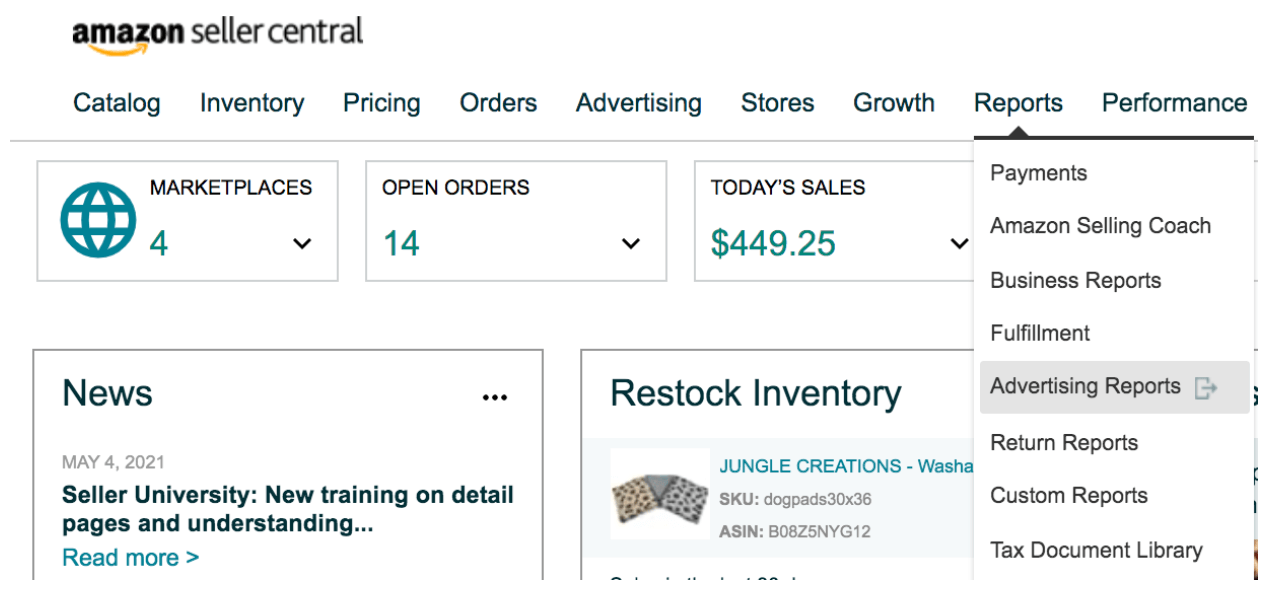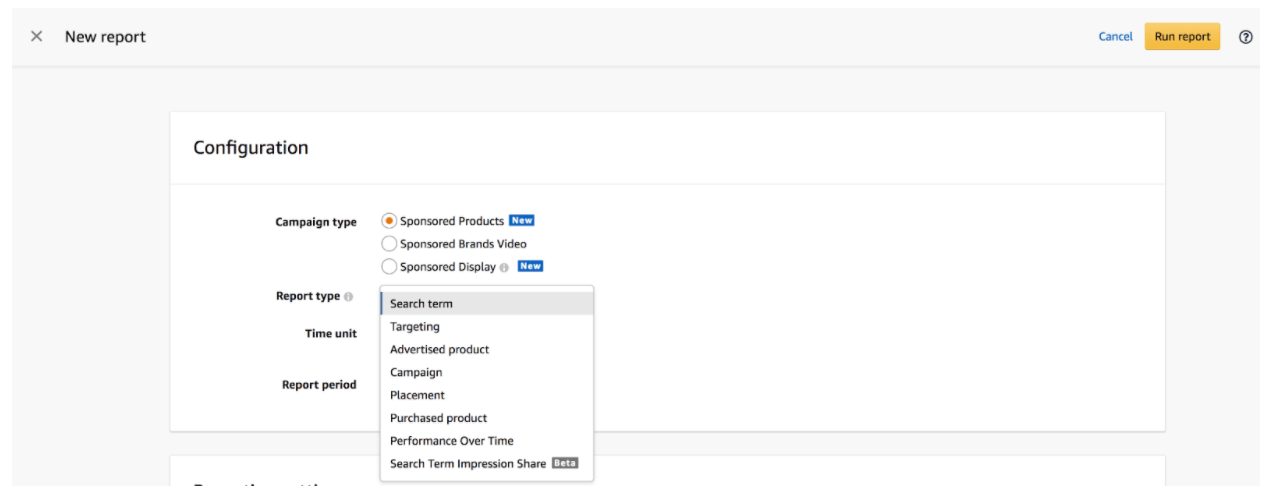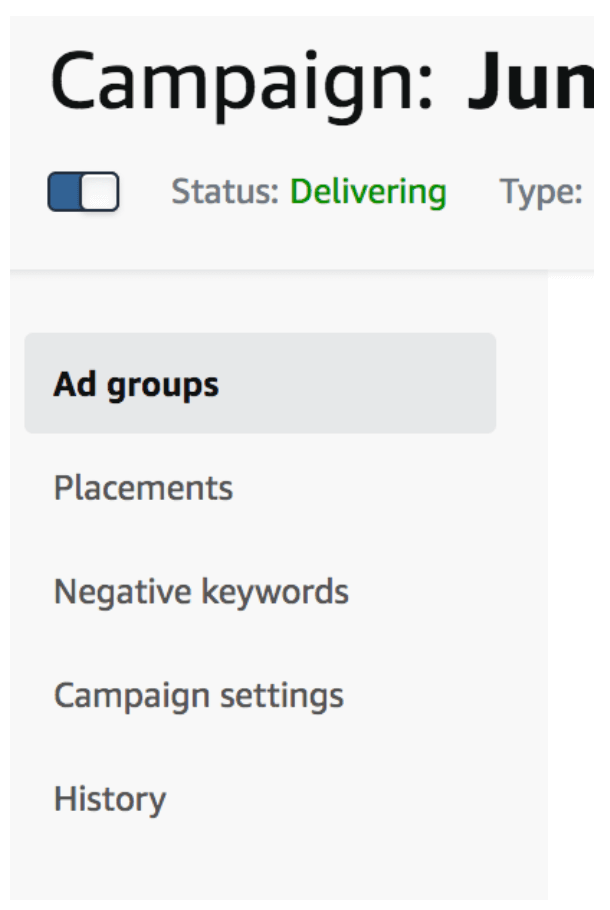As an Amazon seller, you understand the importance of running pay-per-click (PPC) advertising campaigns for your products. But the work doesn’t stop there — you also need to evaluate your ads’ effectiveness, to make sure your advertising budget is well-spent.
If you’re not paying attention, your PPC efforts can quickly become quite expensive, with little return on investment. That’s where Amazon Advertising Reports come in.
Let’s go over how to access your advertising reports and how to interpret them to improve your campaigns and maximize ROI.
Types of Amazon PPC Advertising Reports
While your ad campaigns are live, Amazon is collecting tons of data that indicate exactly how well — or poorly — your campaigns are performing.
There are quite a few ad reports available to sellers. You can run a report based on the campaign type — either Sponsored Products, Sponsored Brands, or Sponsored Display. Then, for each type of PPC campaign, you can select from a variety of report subtypes. Through these reports, sellers have access to revealing metrics such as customer search terms, clicks, click-through rates, impressions, ACOS, and more.
Sponsored Products reports include: Targeting report, advertised product report, campaign report, search term report, search term impression share report, placement report, performance overtime report, and purchased product report (sellers only, not vendors.)
Sponsored Brands reports include: Keyword report, keyword placement report, campaign report, search term report, search term impression share report, category benchmark report (vendors and sellers only), and the campaign placement report.
Sponsored Display reports include: Campaign report, targeting report, advertised product report, and purchased product report (sellers only, not vendors.)

Before discussing how to interpret these reports, let’s go over how to access them in Seller Central.
How to download advertising reports from Seller Central
In Seller Central, go to “Reports,” then “Advertising Reports.”

If you’ve downloaded reports in the past, this is where you will see them. Click the “Create a report” button on the top.

Then choose the campaign type and report type. You can also choose the frequency of delivery for the report you’re downloading such as “Now”, “Future”, or “Recurring.”

Click “Run report.”

You’ll then be brought to the Reports page where you can download an excel file.
The most useful Amazon PPC reports and how to read them
All reports within Seller Central will provide you with some kind of value, depending on the data you’re looking for. But the most useful reports for optimizing your PPC campaigns are Search Term reports, Targeting reports, and Advertised Product reports.
Search Term Reports
Ever wonder how customers stumble upon your Amazon listings, and which of your targeted keywords actually help make it happen? Search term reports answer these questions by revealing the exact keywords that real Amazon customers use to find — and then purchase — your and your competitors’ products, as well as which keywords drive the most conversions and incur the highest ACoS.
Search term reports are therefore very useful when deciding which keywords to continue targeting with your PPC campaigns, which ones to add, and which ones aren’t worth their CPC. Use their insights to add high-yield, specific search terms to your PPC campaigns, and nix the low performers.
How to read a Search Term report
Search Term reports display the following helpful metrics in a single spreadsheet:
- Campaign start date and end date
- Portfolio name
- Campaign Name
- Ad Group Name
- Targeting (keyword targeted)
- Match Type
- Customer Search Term
- Impressions*
- Clicks/Click-Thru Rate (CTR)
- Cost Per Click (CPC)
- Spend
- 7 Day Total Sales
- Total Advertising Cost of Sales (ACoS)
- Total Return on Advertising Spend (RoAS)
*Note that the number of impressions displayed the reports may not match what’s listed in Seller Central’s Campaign Manager. That’s because the search term report only includes search terms that resulted in at least one customer click.
Since Amazon organizes the data neatly in a spreadsheet, you can filter it according to which issue you want to analyze (i.e. low impressions, high CPC, etc.).
When analyzing search term reports, I like to filter the data by ACoS (shown below as “Total Advertising Cost of Sales”). That way, I can quickly identify which keywords aren’t performing well, and get rid of them to optimize my ad spend.

I’ll take note of any keywords that are getting clicks but no sales, and add them to my “negative keyword” list. That way, my ad won’t appear for these search terms (and I won’t pay for clicks that don’t convert). To do this, find the corresponding campaign within Campaign Manager and click “Negative keywords.”

Now let’s talk about the occasional incongruity you’ll notice between targeted versus actual search terms. Notice how the keywords in the “Targeting” column don’t always exactly match those under “Customer Search Term”?
When I notice a customer search term with a low ACoS, I move it into a “Phrase” or “Exact” match campaign, since I now know that customers are using it to find my product.
In the screenshot above, you can see that many of the keywords I target have low click through rates. But their total ACoS and RoAS make them worth keeping in my campaigns.
You can also view whether the search terms Amazon has chosen for your automatic campaign are performing well. If you find new keywords worth paying for in the automatic campaign data, add them into your manual phrase or exact match campaigns.
When sorting through data from your automatic campaigns, you may also notice ASINs mixed in with customer search terms.

This indicates that Amazon showed your ad on one of your competitor’s listing pages. If you don’t want your ads showing up on a particular competitor’s listing, you can add that ASIN to your negative keywords list. On the flip side, if that ASIN targeting is getting impressions, clicks, and sales, you can target that specific ASIN using Sponsored Product or Sponsored Brands ads.
Targeting Reports and Keyword Reports
Targeting reports (for Sponsored Product campaigns) and similarly, keyword reports (for Sponsored Brand campaigns), provide detailed insights into sales and performance metrics for targets in all campaigns that received at least one impression.
Download these reports to see how your targets and keywords have performed over the past 90 days — this can help you adjust your bid and expand your targets to improve your campaign’s overall performance.
The targeting report shows you everything you are targeting for each of your campaigns, including keywords, categories, or specific ASINs. Unlike Search Term reports, these won’t show you customers’ search terms.
Targeting reports provide you with the following metrics:
- Date
- Portfolio name
- Campaign Name
- Ad Group Name
- Targeting
- Match Type
- Impressions
- Clicks
- Click-Thru Rate (CTR)
- Cost Per Click (CPC)
- Spend
- Total Advertising Cost of Sales (ACoS)
- Total Return on Advertising Spend (RoAS)
- 7 Day Total Sales
- 7 Day Total Orders (#) etc.
Targeting reports help you understand how your targets are performing over time, so you can optimize your bids, identify any duplicate keywords, and detect other potential issues with your listings.
For instance, if you have a keyword with a high click-through rate but low impressions, it could mean your bid for that target is too low — it’s enticing, but not enough customers are viewing it. By increasing the bid, you stand to get more impressions.

Also, pay attention to the targets that do not have an ACoS. This means that customers are clicking on your ads, but for whatever reason, they’re not purchasing your product. These keywords are eating up your ad budget — move them to your negative keyword list so your ad spend can go toward targets that convert.
Keywords that gain a lot of impressions and clicks but no sales could also indicate that there’s something wrong with listing, or that the target is too broad. Make sure your listing is fully optimized and contains helpful content customers are looking for. Is your price too high? Are your images poor? See what improvements you can make to encourage conversions.
Over time, as you remove poor performing keywords from your campaigns, you’ll notice your ACoS decrease, and your overall daily budget lasting longer.
Advertised Product Report
Advertised product reports provide insights into sales and performance metrics for advertised ASINs in all campaigns that received at least one impression.
Basically, they show sellers which of their ASINs are getting the most impressions over the last 90 days, broken up by campaign name and ad group name. That way, you can view ad performance for your account both as a whole and at the individual ASIN or SKU level for every ad group.
Advertising Product reports display the following metrics:
- Start Date/End Date
- Portfolio name
- Campaign Name
- Ad Group Name
- Advertised SKU
- Advertised ASIN
- Impressions
- Clicks
- Click-Thru Rate (CTR)
- Cost Per Click (CPC)
- Spend
- 7 Day Total Sales
- Total Advertising Cost of Sales (ACoS)
- Total Return on Advertising Spend (RoAS)
- 7 Day Total Orders (#) etc.
You’ll be able to see how many impressions each campaign received, and what you spent to run each campaign.

You can also view the 7-day conversion rate for each ad group, which gives you insights on where your efforts are best spent, and which areas need tweaking. For instance, maybe you notice that your Broad Match ads have a low conversion rate. In that case, you can use the Search Term and Targeting reports to figure out which keywords or targets might be to blame.

Other Amazon PPC report Types
Purchased product report
Sometimes, your Sponsored Product or Sponsored Display ad for one product will lead customers to purchase a different product in your line. The purchased product report will show you exactly which of your non-advertised products customers actually buy after clicking on your ad.
After viewing it, you can decide whether or not you need to add these products, or particular variations or ASINs to your campaigns.
Purchased product reports data is available for the last 60 days.
Search term impression share report (SIS)
This report will tell you the numeric rank of your impression share relative to other advertisers for each individual keyword that you are targeting. Basically, it compares your ads to your competitor’s ads, for Sponsored Products or Sponsored Brands.
For example, if you ran a Sponsored Product ad targeting the keyword “baseball hat,” your SIS report will show you where you rank in impressions among other baseball hat sellers on a given day. If the report shows your impression share is 25% on May 1st, that means you won 25% of all the Sponsored Product impressions for the keyword “baseball hat” that day.
Armed with this information, you can figure out if you need to increase your bids on specific keywords to boost your impression share.
SIS insights are available for the previous 65 days.
Placement report
Location, location, location: depending on your bid, your Sponsored Product ads could show up at the top of Amazon search results, somewhere in the middle or near the bottom, or on a competitor’s product detail page. The placement report compares your ad’s performance based on its location.
For example, if your ad performs better when shown at the top of the search results, this report will let you know. You can take that knowledge and adjust your bids to increase your chances of winning the top of search placement.
Placement reports data is available for the last 90 days.
Campaign placement report
Similar to the placement report for Sponsored Products, this report shows you how your Sponsored Brands campaigns perform across different placement types on Amazon.
Campaign placement reports data is available for the last 90 days.
Keyword placement report
For Sponsored Brand ads, you can also view sales and performance metrics for keywords across each placement type. Use this information to make bid adjustments and expand your keyword target list.
Keyword placement reports offer a custom date range of the last 90 days.
Campaign report
The campaign report gives an overview of your campaign’s performance as a whole. It’ll show you where you need to optimize or where you may benefit from a bigger budget.
For Sponsored Brands, campaign report data is available for the last 60 days. For Sponsored Products, campaign reports data is available for the last 18 months.
Performance over time report
If you want the broadest overview of your ad spend and performance, use this report. You’ll be able to view the clicks, cost per click (CPC), and spend for all of your Sponsored Products Campaigns.
Overall, this is not a report I would recommend focusing on when trying to optimize your PPC campaigns — it’s not as detailed as other reports, and the insights aren’t as helpful.
Performance over time report data is available for the last 90 days.
I know that is a lot of information we just threw at you, but understanding all of your options as a seller will help you implement the most effective advertising strategies.
Understand how your Amazon business is performing with PPC reports
I encourage you to download each report type and dig into the data that Amazon provides to see if it’s useful for you.
On top of the advertising reports, Amazon provides sellers with detailed business reports, fulfillment reports, return reports, and more. It can be a bit overwhelming to go through each one, but it is important to fully know the ins and outs of your Amazon business.
Do you have more questions on advertising reports? Let us know in the comments!

 8 Comments
8 Comments
8 comments on “Amazon PPC Reports 2021 Guide”